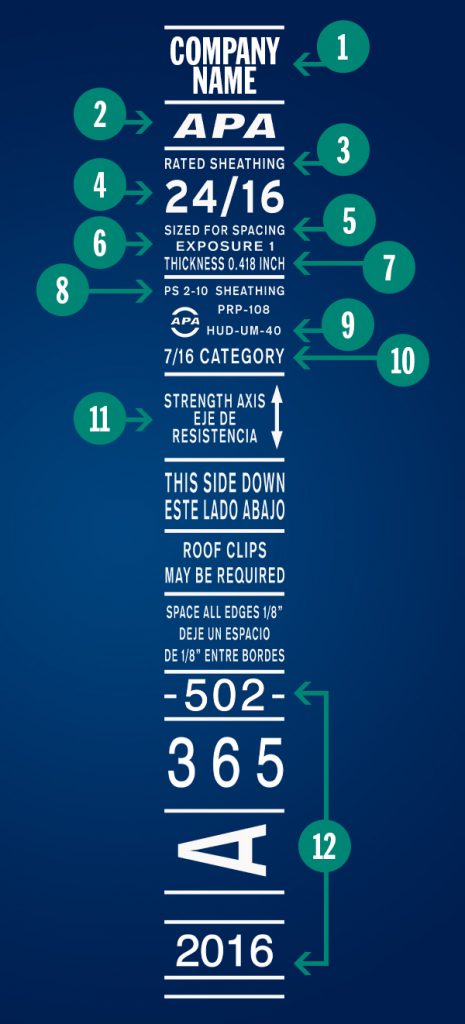
Ever wondered what the information on your OSB sheathing panel stamp means? This stamp offers vital information for construction professionals as well as guidelines for installation. Here’s a rundown on how to read an APA grade stamp from the APA (The Engineered Wood Association) and what it represents.

- Company logo.
- APA is a third-party quality control association that represents US and Canadian manufacturers of structural engineered wood products.
- Panel Grade – Common grades are Rated Sheathing and Strud-I-Floor. Rated Sheathing OSB panels are for Roofs and Walls. Sturd-I-Floor indicates a sub-floor end use.
- Span Rating – Refers to the maximum center to center support spacing when panels are installed during typical construction. The first number indicates roof and wall support spacing. The second number is for floors (2 layers may be required to meet code). Sturd-I-Floor grade stamp will only display one number that indicates maximum joist spacing.
- Sized for spacing – panels are manufactured to allow for the required 1/8” spacing along edges.
- Exposure 1 Bond Classification: A bond classification for structural panels suitable for uses not permanently exposed to the weather. Panels classified as Exposure 1 are intended to resist the effects of moisture on structural performance due to active construction.
- Thickness of the Panel.
- PS 218 refers to the U.S. Voluntary Product Standard. It is a Performance Standard for wood-based structural used panels.
- HUD/FHA Recognition.
- Thickness Category.
- The strength axis indicates the direction of the board that has the most strength. When installing subfloor and roofing, the panels must be installed with the strength axis perpendicular to the supports. When installing walls, the strength axis can run either vertically or horizontally to supports.
- Mill Number, Date, and shift code– each mill in North America has a dedicated mill number that gets printed on the OSB panel along with the date and shift code. This allows the inspector to easily identify where and when the OSB board was manufactured.
Some mills use a Julian calendar as in the example below:

While other mills utilize a regular calendar. Here’s an example from an inkjet stamp:

There are two different methods of printing APA stamps on OSB – Inkjet and rubber. The equipment at the mill will determine what type of stamp that is printed on the OSB.
